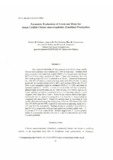Economic evaluation of grow-out diets for Asian catfish Clarias macrocephalus (Gunther) production
Share
Abstract
The economic feasibility of four grow-out diets for the Asian catfish Clarias macrocephalus was evaluated on a 1000 m2/crop basis. Hatchery-bred catfish juveniles with mean body weight (MBW) of 3.6 g and mean total length (MTL) of 7.8 cm were stocked at 10 fish/m2. Laboratory-formulated diet with 20% crude protein (CP; Diet 1) resulted in net losses. Laboratory-formulated diet with 34% CP (Diet 2), commercial feed pellet with 29% CP (Diet 3), and a mixed diet of blanched chicken entrails (80%) and rice bran (20%) with 32% CP (Diet 4) gave acceptable return on investment (ROI) of 131-326% and return on operating capital of 52-71%. Culture of Asian catfish fed Diet 2, however, attained higher net profit before tax per 1000 m2/crop, ROI (326%), and has the lowest payback period on investment (0.3 yr) or operating capital (1.4 yr) compared with using Diets 3 and 4. Partial budget analysis showed that higher net benefit can be earned by using Diet 2 as feed for C. macrocephalus compared with using Diet 4. Sensitivity analysis done by increasing in feed cost by 20% and decreasing the selling price of fish by 20% showed that ROI were 107-262% and 46-159%, respectively and return on operating capital of 42-57% and 18-35%, respectively. Payback period on investment were 0.4-0.9 yr and 0.6-1.9 yr, respectively while payback period on operating capital were 1.7-2.2 yr and 2.7-4.7 yr, respectively. Results suggest that C. macrocephalus culture is economically feasible with Diets 2, 3 and 4 as feed but the use of Diet 2 is more profitable.
Suggested Citation
Coniza, E. B., Tan-Fermin, J. D., Catacutan, M. R., Triño, A. T., & Agbayani, R. F. (2000). Economic evaluation of grow-out diets for Asian catfish Clarias macrocephalus (Gunther) production. UPV Journal of Natural Sciences , 5(2), 43-54. http://hdl.handle.net/10862/1863
Collections
- AQD Journal Articles [1248]

